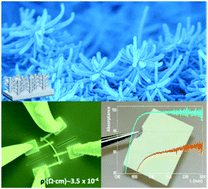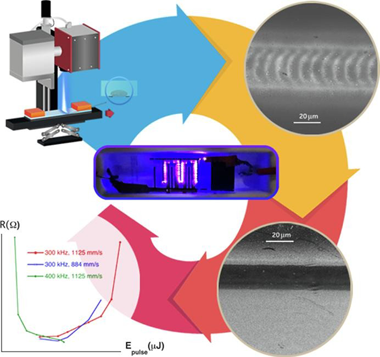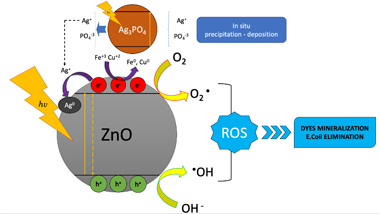Scientific Papers in SCI
2021
2021
Nanotecnología en Superficies y Plasma - Materiales Ópticos Multifuncionales
One-reactor vacuum and plasma synthesis of transparent conducting oxide nanotubes and nanotrees: from single wire conductivity to ultra-broadband perfect absorbers in the NIR
Castillo-Seoane, J; Gil-Rostra, J; Lopez-Flores, V; Lozano, G; Ferrer, FJ; Espinos, JP; Ostrikov, K; Yubero, F; Gonzalez-Elipe, AR; Barranco, A; Sanchez-Valencia, JR; Borras, ANanoscale, 13 (2021) 13882-13895
Show abstract ▽

The eventual exploitation of one-dimensional nanomaterials needs the development of scalable, high yield, homogeneous and environmentally friendly methods capable of meeting the requirements for fabrication of functional nanomaterials with properties on demand. In this article, we demonstrate a vacuum and plasma one-reactor approach for the synthesis of fundamental common elements in solar energy and optoelectronics, i.e. the transparent conducting electrode but in the form of nanotube and nanotree architectures. Although the process is generic and can be used for a variety of TCOs and wide-bandgap semiconductors, we focus herein on indium doped tin oxide (ITO) as the most previously researched in previous applications. This protocol combines widely applied deposition techniques such as thermal evaporation for the formation of organic nanowires serving as 1D and 3D soft templates, deposition of polycrystalline layers by magnetron sputtering, and removal of the templates by simply annealing under mild vacuum conditions. The process variables are tuned to control the stoichiometry, morphology, and alignment of the ITO nanotubes and nanotrees. Four-probe characterization reveals the improved lateral connectivity of the ITO nanotrees and applied on individual nanotubes shows resistivities as low as 3.5 +/- 0.9 x 10(-4) omega cm, a value comparable to that of single-crystalline counterparts. The assessment of diffuse reflectance and transmittance in the UV-Vis range confirms the viability of the supported ITO nanotubes as random optical media working as strong scattering layers. Their further ability to form ITO nanotrees opens a path for practical applications as ultra-broadband absorbers in the NIR. The demonstrated low resistivity and optical properties of these ITO nanostructures open a way for their use in LEDs, IR shields, energy harvesting, nanosensors, and photoelectrochemical applications.
August, 2021 | DOI: 10.1039/d1nr01937f
Nanotecnología en Superficies y Plasma
Laser-induced scanning transfer deposition of silver electrodes on glass surfaces: A green and scalable technology
Molina, R; Ertugrul, M; Larrea, A; Navarro, R; Rico, V; Yubero, F; Gonzalez-Elipe, AR: De la Fuente, GF; Angurel, LAApplied Surface Science, 556 (2021) 149673
Show abstract ▽

A pulsed laser ablation backwriting technique with high repetitive rates is implemented for the fabrication of silver coatings on glass surfaces. This method enables geometrical constraint-free deposition of metallic coatings. These exhibit sufficiently low electrical resistance to be used as electrodes in dielectric barrier discharge (DBD) plasma elements. Ambient air deposition of metallic silver electrodes on standard glass slides is explored using a sub-ns UV laser source, combined with hybrid beam scanning methods. The green nature of the overall deposition process includes a preliminary irradiation scan to homogenise the target surface before the subsequent backwriting step. Metal transfer is achieved by combining two phenomena within a simple beam scanning process: LIRT (laserinduced reverse transfer) of silver from the target to the glass, with a partial and secondary LIFT (Laser-Induced Forward Transfer) of silver from the glass to the target. Appropriate selection of pulse energy and pulse repetition rates, beam scanning velocities and target motion enable the growth of sufficiently thick Ag deposits on glass with the required low electrical resistivity and nearly 2D constraint-free geometry. This method avoids the use of vacuum and liquids, resulting in a cheap, facile and green methodology for the deposition of silver electrodes onto transparent substrate surfaces.
August, 2021 | DOI: 10.1016/j.apsusc.2021.149673
Fotocatálisis Heterogénea: Aplicaciones
ZnO/Ag3PO4 and ZnO–Malachite as Effective Photocatalysts for the Removal of Enteropathogenic Bacteria, Dyestuffs, and Heavy Metals from Municipal and Industrial Wastewater
Murcia, JJ; Hernández Miño, JS; Rojas, H; Brijaldo, MH; Martin-Gómez, AN; Sánchez-Cid, P; Navío, JA; Hidalgo, MC; Jaramillo-Pérez, CWater, 13 (2021) 2264
Show abstract ▽

Different composites based on ZnO/Ag3PO4 and ZnO–malachite (Cu2(OH)2CO3) were synthesized in order to determine their effectiveness in the treatment of municipal and industrial wastewaters (mainly polluted by enteropathogenic bacteria, dyes, and heavy metals). The addition of Ag3PO4 and malachite did not significantly modify the physicochemical properties of ZnO; however, the optical properties of this oxide were modified as a result of its coupling with the modifiers. The modification of ZnO led to an improvement in its effectiveness in the treatment of municipal and industrial wastewater. In general, the amount of malachite or silver phosphate and the effluent to be treated were the determining factors in the effectiveness of the wastewater treatment. The highest degree of elimination of bacteria from municipal wastewater and discoloration of textile staining wastewater were achieved by using ZnO/Ag3PO4 (5%), but an increase in the phosphate content had a detrimental effect on the treatment. Likewise, the highest Fe and Cu photoreduction from coal mining wastewater was observed by using ZnO–malachite (2.5%) and ZnO/Ag3PO4 (10%), respectively. Some of the results of this work were presented at the fourth Congreso Colombiano de Procesos Avanzados de Oxidación (4CCPAOx).
August, 2021 | DOI: 10.3390/w13162264
Materiales Ópticos Multifuncionales - Materiales Coloidales
Persistent luminescent nanoparticles: Challenges and opportunities for a shimmering future
Castaing, V.; Arroyo, E.; Becerro, A.I.; Ocaña, M.; Lozano, G.; Míguez, H.Journal of Applied Physics, 130 (2021) 080902
Show abstract ▽
Persistent phosphors are luminescent sources based on crystalline materials doped with rare-earth or transition metal cations able to produce light after the excitation source vanishes. Although known for centuries, these materials gained renewed interest after the discovery of Eu2+,RE3+ co-doped aluminates and silicates in the late 1990s due to their unprecedented afterglow properties. In contrast, persistent nanophosphors have emerged only recently as a nanoscale alternative to their bulk counterparts, offering exciting opportunities of particular relevance for in vivo imaging, optical data storage, or unconventional light generation. However, taking advantage of the avenues opened by nanoscience demands developing new synthetic strategies that allow precise control of the morphology, surface, and defect chemistry of the nanomaterials, along with a profound understanding of the physical mechanisms occurring in the nanoscale. Besides, advanced physicochemical characterization is required to assess persistent luminescence in a quantitative manner, which allows strict comparison among different persistent nanophosphors, aiming to propel their applicability. Herein, we revisit the main phenomena that determine the emission properties of persistent nanoparticles, discuss the most promising preparation and characterization protocols, highlight recent achievements, and elaborate on the challenges ahead.
August, 2021 | DOI: 10.1063/5.0053283
Reactividad de Sólidos
Study of the Influence of Sintering Atmosphere and Mechanical Activation on the Synthesis of Bulk Ti2AlN MAX Phase Obtained by Spark Plasma Sintering
Salvo, C; Chicardi, E; García-Garrido, C; Poyato, R; Jimenez, JA; Mangalaraja, RVMaterials, 14 (2021) 4574
Show abstract ▽
The influence of the mechanical activation process and sintering atmosphere on the microstructure and mechanical properties of bulk Ti2AlN has been investigated. The mixture of Ti and AlN powders was prepared in a 1:2 molar ratio, and a part of this powder mixture was subjected to a mechanical activation process under an argon atmosphere for 10 h using agate jars and balls as milling media. Then, the sintering and production of the Ti2AlN MAX phase were carried out by Spark Plasma Sintering under 30 MPa with vacuum or nitrogen atmospheres and at 1200 degrees C for 10 min. The crystal structure and microstructure of consolidated samples were characterized by X-ray Diffraction, Scanning Electron Microscopy, and Energy Dispersive X-ray Spectroscopy. The X-ray diffraction patterns were fitted using the Rietveld refinement for phase quantification and determined their most critical microstructural parameters. It was determined that by using nitrogen as a sintering atmosphere, Ti4AlN3 MAX phase and TiN were increased at the expense of the Ti2AlN. In the samples prepared from the activated powders, secondary phases like Ti5Si3 and Al2O3 were formed. However, the higher densification level presented in the sample produced by using both nitrogen atmosphere and MAP powder mixture is remarkable. Moreover, the high-purity Ti2AlN zone of the MAX-1200 presented a hardness of 4.3 GPa, and the rest of the samples exhibited slightly smaller hardness values (4.1, 4.0, and 4.2 GPa, respectively) which are matched with the higher porosity observed on the SEM images.
August, 2021 | DOI: 10.3390/ma14164574
- ‹ previous
- 70 of 410
- next ›














